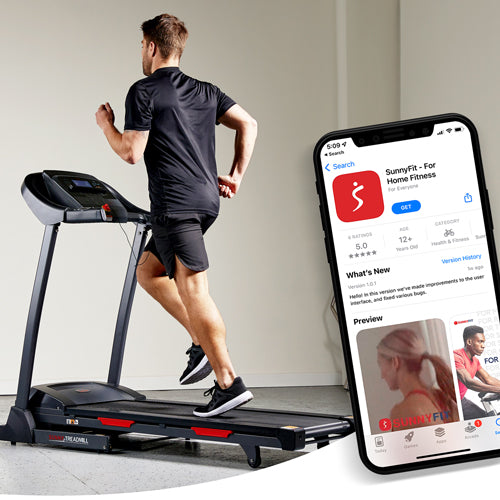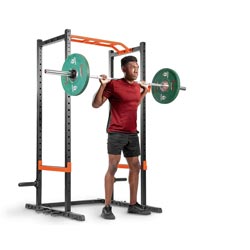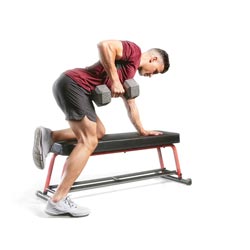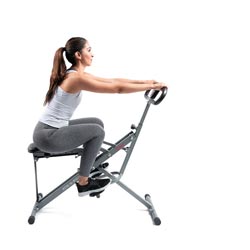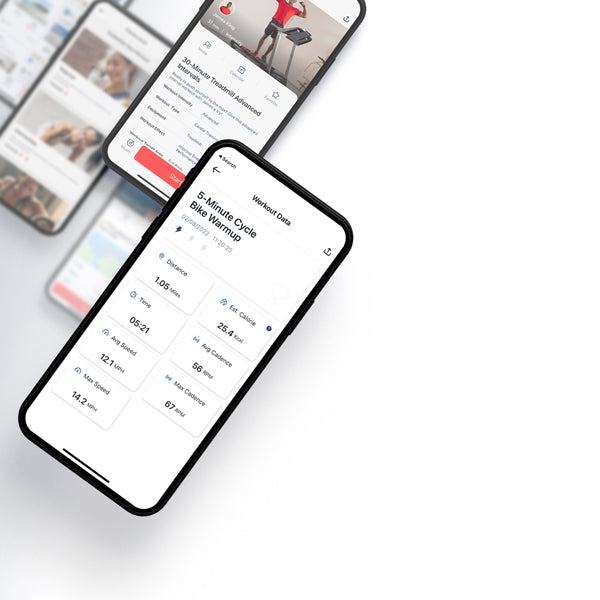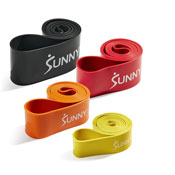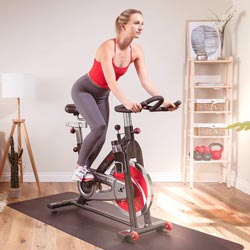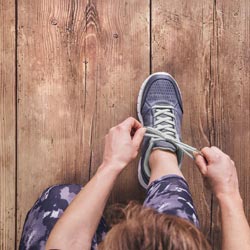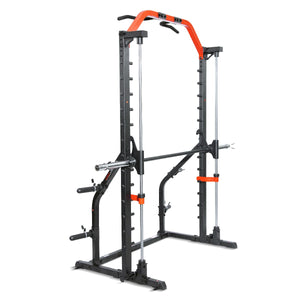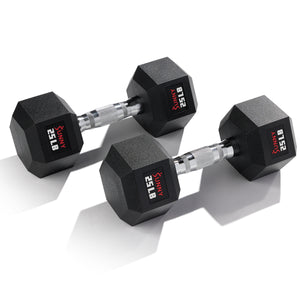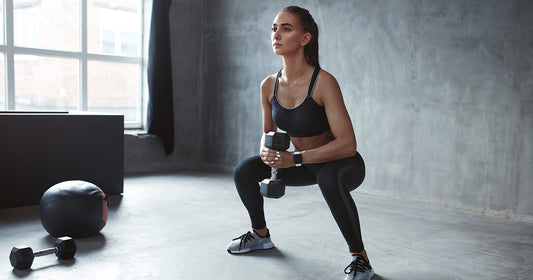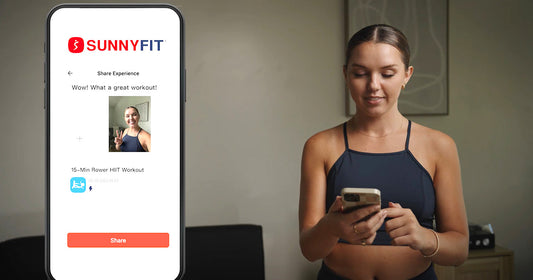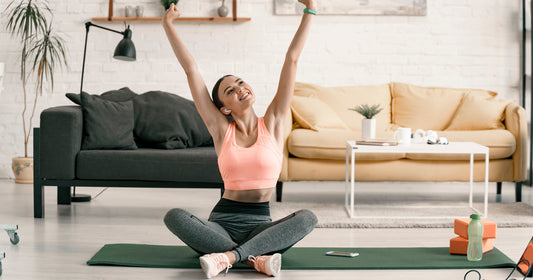If you’ve ever had a “leg day” in your workout routine, you’ve probably experienced the temptation to skip it. Leg day workouts tend to be hard, humbling, tiring, and sometimes even the biggest offender: boring.
So what do we do about it? Get rid of leg days? The only good reason to do this is if you have no legs (or are injured). So that’s not an option.
Should we make leg day workouts easy? Imagine: showing up at the gym, doing one set of light weights, and then saying, “OK, good; leg day is out of the way.”
I mean, it’s better than nothing. But is “better than nothing” your long-term plan?
I hope not.
So then, what to do?
In this article, I'll go over 6 leg day training methods to spice up your workout routine. Some of them work best with just one Leg Day per week, and others produce better results if you work your legs more than one day per week. So get ready!
Furthermore, these leg day training methods might pertain to goals—like building power or muscle size—other than your current primary objective.
But one thing’s for sure: if you use even one of them, and commit to it, and do it “for real” and not half-heartedly, you’ll be able to get in on your Leg Day(s), do a leg day workout, and mean it when you say, “Now THAT was a Leg Day!”
Let’s hop in!
Weighted Stretches
Most people view stretches mainly as a way to increase mobility. This is valid, of course, but another documented use for them is less well-known: building muscle.
A weighted stretch involves pausing at the point in an exercise where the muscle you’re working is at its longest (i.e., most stretched) point. In a squat, that’s at the bottom. In a Romanian Deadlift, it’s when you’re the most bent-over. In a calf raise, it’s when your heel is low.
Weighted stretching involves being forced into positions that may be new to you, so don’t rush into them. Also, for the actual 30-second stretch, don’t be surprised if you have to lower the weight.
The simplest way to implement them is to add a weighted stretch at the end of your usual set. A good leg day workout that uses weighted stretching might look like this:
End each set, or each final set, with a 30-second weighted stretch
| LEG DAY WORKOUT: Weighted Stretch | Stretch Location |
| Goblet Squat with Heels Elevated 3x10. | Quadriceps |
| Trap Bar Romanian Deadlift 3x8. | Hamstrings |
| Hip Thruster 3x12. | Glutes |
| Calf Raise 3x15. | Calves |
Antagonistic Superset
Muscular antagonism refers to a specific relationship between muscles. It simply means that when one muscle is contracting during an exercise, the other one is lengthening. Another way of saying it is that these muscles are the “opposite” of each other.
Therefore, an antagonistic superset means a pair of exercises that work opposing muscle groups, like the biceps and the triceps, or in the case of a leg day workout, the quads and the hamstrings.
Evidence suggests that antagonistic supersets are not only just as effective for building muscle, but also save time.
As with weighted stretches, the thing to remember is that you may not be able to handle the heaviest weight possible during such a superset.
| LEG DAY WORKOUT: Antagonistic Supersets | Superset With: |
| 1a: Barbell Back Squat | 1b: Dumbbell Romanian Deadlift |
| 2a: Walking Lunge | 2b: Ball Ham Curl |
| 3a: Weighted Glute Bridge | 3b: Lying Leg Raise |
Unilateral Leg Training
Unilateral means “one side,” as in, lifting a weight with only one leg at a time. You can easily spice up your leg routine by incorporating unilateral exercises, and you can improve your overall health and fitness while you do it.
What makes unilateral training so special is its capacity to reveal muscular imbalances. Take note of them and try to correct them. You’re going to want to train both sides on the same day, but always start on the weaker side (if there is one) first.
| LEG DAY WORKOUT: |
| Split Squat 3x10 per side |
| Kickstand RDL 3x8 per side |
| Unilateral Glute Bridge 3x12 per side |
Plyometric Leg Training
Plyometric training refers to exercises that involve maximizing power output. What does this mean? Rather than moving the largest amount of weight possible, (which is what strength training is all about), power training involves being able to apply the maximum amount of force as fast as possible.
So, activities like jumping and throwing are known as “plyometric.”
Spice up your leg day (and burn some extra bodyfat) with plyometrics! These supersets combine some traditional lower-body lifts with their plyometric counterparts.
| LEG DAY WORKOUT: Plyometric | Superset with: |
| 1a. Barbell Box Squat 3x8. | b. Box Jump 1x6, 1x8, 1x10. |
| 2a. Deadlift 3x6. | 2b. Kettlebell Swing 30 seconds, 45 seconds, 60 seconds. |
| 3a. Leg Press. | 3b. Jump Squat 1x8, 1x12, 1x15. |
Bodyweight Leg Training
Bodyweight training, or calisthenics, is becoming more and more popular these days. Most people focus on doing high-rep or weighted pullups, dips, and pushups, but are there any calisthenics movements for the lower body?
You bet there are! And they are TOUGH, but super-rewarding, both physically and emotionally.
The thing with building calisthenics movements is that it involves decent time investment. In fact, training them more than once a week is probably mandatory. But the emotional reward of being able to accomplish them, coupled with their ample muscle-building potential and having them in your toolbox, is worth it.
Get ready for a leg day without barbells OR dumbbells!
| LEG DAY WORKOUT: Bodyweight | TIPS: |
| One-Legged Squat to Box 3x4-10 per side. | Start box height at mid-shin. Reduce box height as you gain experience. |
| Supported Sissy Squat 3x4-10. | Place small plates under your heels. Hold onto a rack, and/or use elastic bands for support as you build up your ability. |
| Nordic Ham Curl 3x6. | Use bands or a partner to build up to it. |
Conjugate Leg Training
Conjugate training refers to pursuing multiple fitness goals in the same exercise program and/or the same workout. In another article, I lay out what your workout would look like if you were concurrently pursuing resistance training and cardio goals at the same time.
In this article, the two training objectives are muscular strength and endurance, with the main purpose being to maximize strength.
Strength training is a wonderful pursuit, but it can get boring doing the same lifts week after week with the same rep ranges, trying to add weight to the bar whatever the cost.
If strength is your goal, one fantastic way to spice it up is to utilize a conjugate training approach. This means that instead of merely training for strength every workout, you alternate between focusing on muscular strength and muscular endurance. Muscular endurance refers to maximizing repetitions rather than strength.
Another aspect of conjugate strength training is exercise rotation. No more having to do the same exact lifts week after week!
LEG DAY WORKOUTS: Conjugate
Note: Day Two should be at least 48 hours after Day One.
| Day One: STRENGTH | Day Two: VOLUME | |
| Week One | Barbell Back Squat 1x5, 1x3, 1x1 Romanian Deadlift 3x6 Leg Press 3x10 |
Heels-elevated Goblet Squat 3x15 Kettlebell Romanian Deadlift 3x12 Static Lunge 3x30 seconds per side |
| Week Two | Barbell Front Squat 1x7, 1x5, 1x3 Stiff-legged Deadlift 3x8 Hip Thruster 3x10 |
Barbell Close-Stance Squat 3x8-12 Ball Ham Curl 3x15 Plie Squat 3x20 |
| Week Three | Barbell Box Squat 1x5, 1x3, 1x1 Barbell Goodmorning 3x8 Sissy Squat 3x10 |
Walking Lunge 3x10 per side Band Pull-Through 3x15 Static Lunge 3x30 seconds per side |
| Week Four | Barbell Pause Squat 1x5, 1x3, 1x1 Bench Reverse Hyper 3x10 Goblet Lunge 3x8 per side |
Barbell Goodmorning 3x12 Double KB Front Squat 3x10 Weighted Glute Bridge 3x15 |
Conclusion
With these 6 techniques, you can personalize and expand your leg-training goals and methods. Although Leg Day should always be challenging (just like any other workout), no longer must it remain this immutable monolith standing square in the middle of each week like a wall.
Now, you can try new ways to improve, new elements to enjoy and look forward to, and of course, new gains!
See you at the squat rack!
1. Krzysztofik M, Wilk M, Wojdała G, Gołaś A. Maximizing Muscle Hypertrophy: A Systematic Review of Advanced Resistance Training Techniques and Methods. Int J Environ Res Public Health. 2019 Dec 4;16(24):4897. doi: 10.3390/ijerph16244897. PMID: 31817252; PMCID: PMC6950543. Accessed 17 May 2023.
2. Neves da Silva VF, Aguiar SDS, Sousa CV, Sotero RDC, Filho JMS, Oliveira I, Mota MR, Simões HG, Sales MM. Effects of short-term plyometric training on physical fitness parameters in female futsal athletes. J Phys Ther Sci. 2017 May;29(5):783-788. doi: 10.1589/jpts.29.783. Epub 2017 May 16. PMID: 28603345; PMCID: PMC5462672. Accessed 17 May 2023.
3. Pedrosa GF, Lima FV, Schoenfeld BJ, Lacerda LT, Simões MG, Pereira MR, Diniz RCR, Chagas MH. Partial range of motion training elicits favorable improvements in muscular adaptations when carried out at long muscle lengths. Eur J Sport Sci. 2022 Aug;22(8):1250-1260. doi: 10.1080/17461391.2021.1927199. Epub 2021 May 23. PMID: 33977835. Accessed 17 May 2023.



Mark Ludas CPT is a NASM-certified personal trainer with a decade of experience in the fitness industry. After an asthmatic childhood, Mark discovered his natural aptitude for fitness in his late twenties. At age 36, he accomplished a 300+ pound conventional deadlift and 280+ high-bar squat as a 6’5” 170-pound ectomorph on a fully vegan diet, all after just one year of proper self-programming. Mark is the founder of Resistance Quest Fitness, established in 2016. Additionally, he is a writer, actor, model, and musician. Find him on Instagram, Facebook, Youtube, and at www.resistancequest.com.
